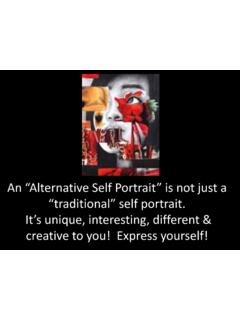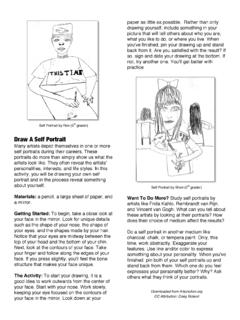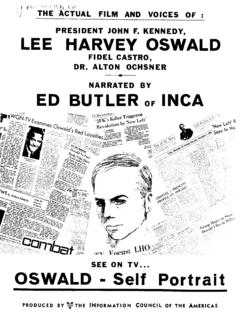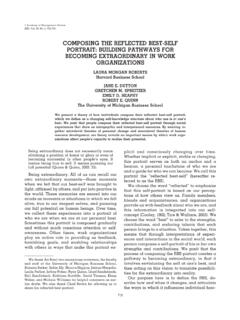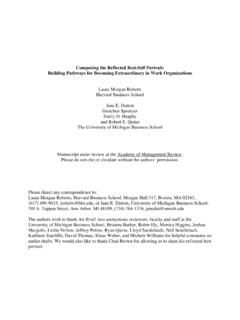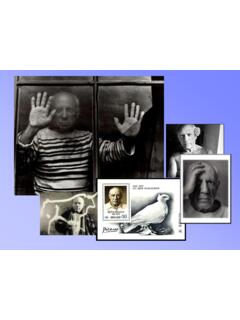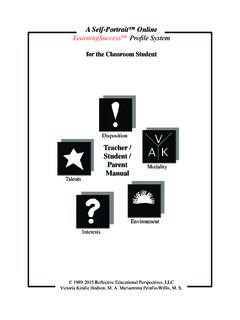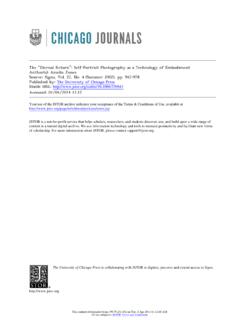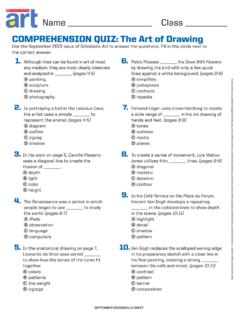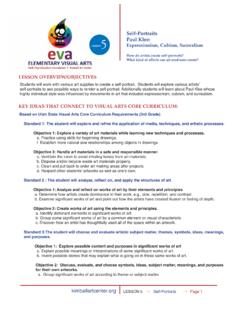Transcription of Career Self-Portrait - lmi.mt.gov
1 Career self -PortraitTheme and LevelTheme: Know Myself Level: Getting Started, Looking DeeperAt a GlanceStudents study the revealing aspects of portraits then create self -portraits and discuss them. Time: 150 minutes (across three days).Essential QuestionsWho am I becoming?How does my Self-Portrait capture who I am becoming?PreparationReserve computer lab with overhead projector enabled for Day OneSet up projector with classroom computer for Days Two and ThreeEstablish CIS portfolios before this lessonRead Setting the Stage for Using Formal Career Assessment Instruments found in Tools for Counselors andTeachers under Guides and Instructional Tools if following activity with assessmentPrint portrait Analysis Worksheet, My Self-Portrait Analysis Worksheet, and My Career Self-Portrait AnalysisWorksheet, one each per studentGather art suppliesOptional.
2 Select a portrait to use as a discussion example or use the PowerPoint example on Slide 2 Optional: Reserve computer lab for Day Three if following activity with Career assessmentStepsDay 11. Show PowerPoint (PPT) Slide 1. Introduce the goal of this lesson: to learn more about who you are becoming bystudying and completing a Self-Portrait . In addition, the class will examine one or more historical portraits andstudy how portraits contribute to our understanding of the personalities, lives, and times of those who lived inthe past. Explain that students will create their own self -portraits using the medium they choose.
3 This Self-Portrait should indicate who they are and how they fit into their Show (PPT) Slide 2, which is a portrait of John Quincy Adams. Ask students to discuss the following aspects ofthe portrait :What is the setting?What colors are used?What is the person's pose?What is the person wearing?What are other components in the portrait ?How do these elements affect our understanding of the subject of the portrait ?3. Show (PPT) Slide 3. Distribute the portrait Analysis Worksheet. Ask students to use art history books, theinternet, or other resources to find and select a historical portrait to study individually or in a small them to use the worksheet to record how each of the portraits' elements affect their impression of Ask students to share their worksheet with a small group or the class.
4 Day 21. Show (PPT) Slide 4. Ask students to consider what they would like to convey in a portrait of the My Self-Portrait Analysis Worksheets, and suggest that they make notes about important aspectsand elements of their Self-Portrait , using the worksheet as a Ask students to begin their portrait in class and assign the completion of the Self-Portrait as Remind students to complete the My Self-Portrait Analysis Worksheet upon finishing this 31. Ask the students to share their finished self -portraits in small groups. Instruct groups to discuss what thedifferent elements of each portrait convey to them.
5 They should discuss how effectively each portraitconveyed what the individual was trying to communicate, using the following prompts:What was effective?What was not?Consider how every element is important in conveying the whole Review the various Career assessments that students will complete in school. Explain how assessments can becompared to portrait elements: each assessment contributes something to the whole Show (PPT) Slide 5. Hand out My Career Self-Portrait Analysis Worksheet. (If you will be using careerassessments subsequent to this activity, ask students to use this worksheet to take notes on what they learnedfrom the assessments.)
6 If not, ask students to save this worksheet and record what they learn when theycomplete the assessments later.)4. Regardless of whether or not you are using a Career assessment immediately, tell students that careerassessments are only snapshots. They cannot capture all of the different aspects that make up who you are,just as the Self-Portrait captures only parts of Remind students that they are the artists of their If using a Career assessment immediately following this activity, introduce the assessment(s) the students willuse and AccommodationsStudents could create videos rather than portraits of could create portraits in one-on-one with any student needing special assistance or pair student with a helpful group the Career Self-Portrait Scoring Guide to evaluate student enter their reflections about this activity in the What do you know about yourself - your characteristics,interests, preferences?
7 Text box in the Know Myself section of Career lab with overhead projector and CIS access Classroom with computer, projector and CIS access for days two and threeCareer Self-Portrait (PPTX) portrait Analysis Worksheet (PDF) portrait Analysis Worksheet (DOCX) My Self-Portrait Analysis Worksheet (PDF) My Self-Portrait Analysis Worksheet (DOCX) My Career Self-Portrait Analysis Worksheet (PDF) My Career Self-Portrait Analysis Worksheet (DOCX) Career Self-Portrait Scoring Guide (PDF) Career Self-Portrait Scoring Guide (DOCX) Art supplies Optional: Sample portrait Optional: Computer lab for Day ThreeGoals and StandardsCommon Core State StandardsEnglish Language Arts Career Anchor: Speaking & ListeningEnglish Language Arts Career Anchor: Reading Informational TextEnglish Language Arts Career Anchor: Language National Career Development GuidelinesGOAL PS1 Develop understanding of self to build and maintain a positive self -concept.
8 American School Counselor AssociationCareer Development; Personal/Social Development Bloom's Taxonomy: Creating, Evaluating, Analyzing American School Counselor Association (ASCA) Mindsets and Behaviors for Student SuccessMindset StandardsPositive Attitude Toward Work and LearningBehavior Standards: Learning StrategiesDemonstrate Critical-Thinking Skills to Make Informed DecisionsDemonstrate CreativityUse Time-Management, Organizational and Study-SkillsSet High Standards of QualityGather Evidence and Consider Multiple Perspectives to Make Informed DecisionsBehavior Standards.
9 self -Management SkillsDemonstrate Ability to Assume ResponsibilityDemonstrate Ability to Work IndependentlyBehavior Standards: Social SkillsUse Effective Oral and Written Communication Skills and Listening SkillsCreate Positive and Supportive Relationships with Other StudentsUse Effective Collaboration and Cooperation SkillsUse Leadership and Teamwork Skills to Work Effectively in Diverse TeamsDemonstrate Advocacy Skills and Ability to Assert self , when NecessaryDemonstrate Social Maturity and Behaviors Appropriate to the Situation and EnvironmentCredits and CitationsThe following portrait study curriculum units were used to form this activity and could be used by the teacher to extend , Amanda Christy, Kristin McGinn Mahoney, and Holly Epstein Ojalvo.
10 "Critical Lenses." The LearningNetwork. The New York Times, 22 May 2009. Web. "What Presidential Portraits Reveal." Edsitement. United States National Endowment for the Humanities, 27 September 2010. Web.

